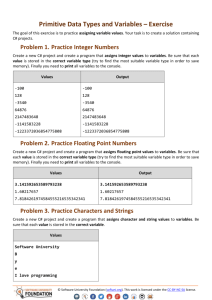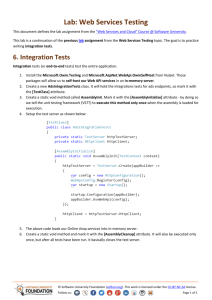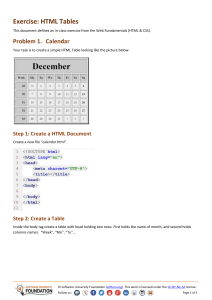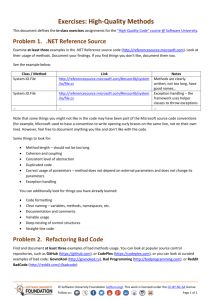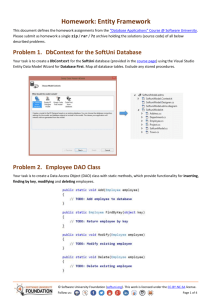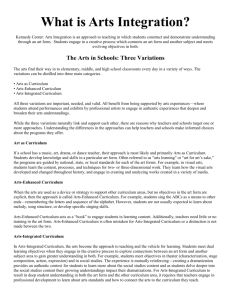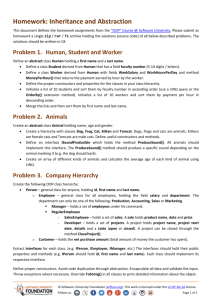Algorithms - Exercises
advertisement
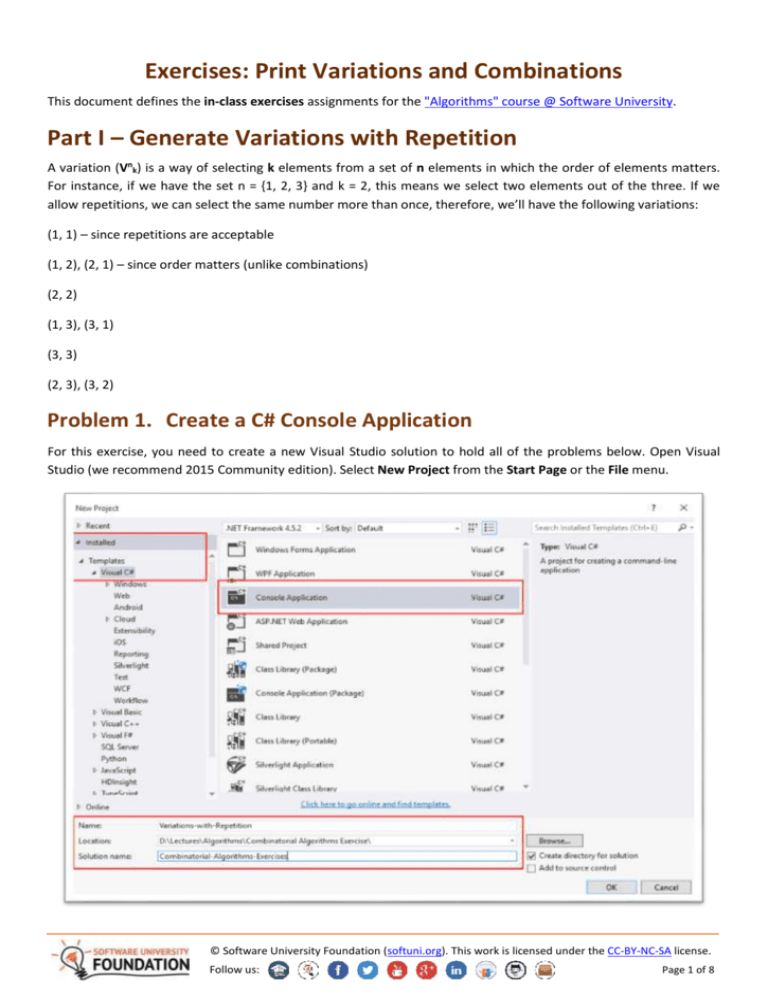
Exercises: Print Variations and Combinations
This document defines the in-class exercises assignments for the "Algorithms" course @ Software University.
Part I – Generate Variations with Repetition
A variation (Vnk) is a way of selecting k elements from a set of n elements in which the order of elements matters.
For instance, if we have the set n = {1, 2, 3} and k = 2, this means we select two elements out of the three. If we
allow repetitions, we can select the same number more than once, therefore, we’ll have the following variations:
(1, 1) – since repetitions are acceptable
(1, 2), (2, 1) – since order matters (unlike combinations)
(2, 2)
(1, 3), (3, 1)
(3, 3)
(2, 3), (3, 2)
Problem 1. Create a C# Console Application
For this exercise, you need to create a new Visual Studio solution to hold all of the problems below. Open Visual
Studio (we recommend 2015 Community edition). Select New Project from the Start Page or the File menu.
© Software University Foundation (softuni.org). This work is licensed under the CC-BY-NC-SA license.
Follow us:
Page 1 of 8
In the pop-up window (see above), select Visual C# from the menu to the right and find the Console Application
template.
At the bottom, there are three fields:
1) Project name – give a meaningful name to your project, e.g. Variations-with-Repetition
2) Location – choose an appropriate location for the project (the place where you keep all course materials)
3) Solution name – a solution is a collection of projects. We’ll use a single solution to hold all projects for this
exercise, so an appropriate name would be Combinatorial-Algorithms-Exercises or something similar
When you’re ready, click OK to finish. A solution with a single project will be created.
Rename the class and the auto-generated file, it is by default called Program.cs. Remove all unnecessary using
directives:
You are now ready to start coding.
Problem 2. Setup
To simplify things, we’ll use hardcoded values for now. Selecting two elements out of 3 is easy to keep track of and it
produces just 9 variations. We’ll need an array of integers to hold each variation we obtain, therefore, it should be
of size k.
© Software University Foundation (softuni.org). This work is licensed under the CC-BY-NC-SA license.
Follow us:
Page 2 of 8
Problem 3. Write the Recursive Method to Generate Variations
The method that will generate the variations, let’s call it GenerateVariations, should accept as parameters: the
array to hold the obtained variations, the size of the set and the current index:
The optional parameter index will allow us to call the method in our Main method like this:
It will loop through all numbers from 1 to n (inclusive) and will place the current number at the current index. Next,
it will generate all variations for the next index onward.
The bottom of the recursion is reached when we’ve filled k elements (we can use the size of the array instead of
passing k to the method). So, the bottom of the recursion is simple, stop when the current index is outside the valid
range. When we reach it, we print the result:
In the else clause, we have the loop from 1 to n:
Complete the TODO by calling the GenerateVariations method.
Problem 4. Write the Print() Method
In the print method, we need to print the currently obtained variation. string.Join makes this a one-liner:
© Software University Foundation (softuni.org). This work is licensed under the CC-BY-NC-SA license.
Follow us:
Page 3 of 8
Problem 5. Test the Code
Run the code. It should produce the following result:
Use the debugger to follow the process step by step and see how each of the results is produced.
Problem 6. Remove Hardcoded Values
Go back to the Main method and replace the hardcoded values for n and k with input from the console:
Problem 7. Test the Code Again
Test with several different values for n and k. Stick to smaller numbers as it will get much harder to check whether
the variations are correct.
Part II – Variations without Repetition
The second problem is to generate variations without repetition, meaning that (1, 1) would no longer be valid. It’s a
simple modification of the previous program.
Problem 8. Create a C# Console Application
In Solution Explorer, right-click the solution and select Add -> New Project.
© Software University Foundation (softuni.org). This work is licensed under the CC-BY-NC-SA license.
Follow us:
Page 4 of 8
Since the problem is solved in almost the same manner like the previous one, copy and paste the code from Part I
to the new project.
Problem 9. Keep Track of Used Numbers
To avoid repetitions, we just need to keep track of all the numbers we’ve already used. This can be done by creating
an array of Boolean values which will simply tell us whether the number was used or not. To keep a correspondence
between the number itself and its index in the new array, we can declare it with size n + 1, thus index 0 will never be
used.
The GenerateVariations method will have to take the new array as a parameter as well:
The idea is the following – we use only numbers which haven’t been used, so we need a conditional statement
inside the for-loop. As soon as we use a number, we mark it as used, then continue generating variations. After the
recursive call, we need to unmark the number.
© Software University Foundation (softuni.org). This work is licensed under the CC-BY-NC-SA license.
Follow us:
Page 5 of 8
Problem 10. Test the Modified Code
Testing the code for n = 2 and k = 2 should produce the following (the same as the previous program, but repetitions
are omitted):
Part III – Generate Combinations with Repetition
In combinations, order does not matter (unlike variations). This means that the combinations (1, 2) and (2, 1) are
considered the same and once we obtain one of them, the other is no longer valid.
Problem 11. Create a C# Console Application
Create a new project for the problem. Follow the steps outlined in problem 8.
Problem 12. Setup
Let’s generate all combinations of 2 numbers from a set of 3 numbers.
Problem 13. Write the Recursive Method
The method to generate combinations is almost the same as the one to generate variations. The difference is that
once we use a given number we can no longer use it afterwards. To achieve this, we’ll declare a new variable start
© Software University Foundation (softuni.org). This work is licensed under the CC-BY-NC-SA license.
Follow us:
Page 6 of 8
which will tell us at each recursive step where we should start the loop. E.g. after we’ve exhausted all combinations
starting with 1, we’ll just start with 2 the next time and won’t go back to 1:
The only adjustments you need to make compared to the first problem (variations with repetition) is to pass the
current number as start when doing the recursive call, and adjusting the loop so that it starts not from 1 every time,
but from the number passed as start:
Problem 14. Write the Print() Method
You may copy the Print() method from any of the previous problems.
Problem 15. Test the Code
Testing the code should produce the following results (remember, n = 3, k = 2):
Problem 16. Remove Hardcoded Values and Retest
This step is the same as problems 6 and 7. Read n and k from the console and run the program several times with
different values to make sure it is correct.
Part IV – Generate Combinations without Repetition
Problem 17. Create a C# Console Application
To keep your work organized, create a new project for the last problem for this exercise. Copy and paste the code
from the previous problem as you’ll only need to make a slight modification.
© Software University Foundation (softuni.org). This work is licensed under the CC-BY-NC-SA license.
Follow us:
Page 7 of 8
Problem 18. Modify the Code
The only difference between this problem and the previous one is that you cannot repeat a number. You achieve
this by incrementing the start variable along with the current number when you call the method recursively (i.e.
the new start should be i + 1, instead of i).
Problem 19. Test
Selecting 2 elements out of 3 should produce the following result:
When repetitions aren’t allowed, the number of combination decreases, so you can test with larger values, e.g. 3
elements out of 5 should produce this result:
This is it! You’ve successfully written the recursive algorithms to generate variations and combinations (with and
without repetition)!
© Software University Foundation (softuni.org). This work is licensed under the CC-BY-NC-SA license.
Follow us:
Page 8 of 8
